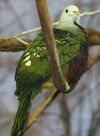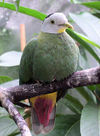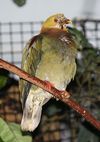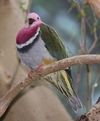Genus Ptilinopus

Ripley's Fruit Dove - Its natural habitat is subtropical or tropical moist lowland forests. It is threatened by habitat loss. In fact, there have been no recorded sightings of it since 1953; it may or may not be extinct.
Orange-fronted Fruit Dove - The Orange-fronted Fruit-dove is a species of bird in the Columbidae family. It is found in Indonesia and Papua New Guinea. Its natural habitats are subtropical or tropical moist lowland forests and subtropical or tropical mangrove forests.
Scarlet-breasted Fruit Dove - Its natural habitat is subtropical or tropical moist lowland forests.
Black-backed Fruit-Dove - Bali, Lesser Sunda Islands and Australia, where it is restricted to the western edge of the Arnhem Land escarpment.
Red-naped Fruit Dove - Its natural habitat is subtropical or tropical moist montanes. It is threatened by habitat loss.
White-headed Fruit Dove - Its natural habitat is subtropical or tropical moist lowland forests. It is threatened by habitat loss.
Fischer's Fruit Dove - Its natural habitat is subtropical or tropical moist montanes.
Carunculated Fruit Dove - Its natural habitats are subtropical or tropical moist lowland forests, subtropical or tropical moist shrubland, and arable land. It is threatened by habitat loss.
Grey's Fruit Dove - Its natural habitat is subtropical or tropical moist lowland forests.
Grey-headed Fruit-Dove - Its natural habitat is subtropical or tropical moist lowland forests.
Henderson fruit-dove - Its natural habitat is subtropical or tropical moist lowland forests. It is threatened by habitat loss.
Orange-bellied Fruit Dove - The dove is found in New Guinea, the Aru Islands and western Papuan islands where it inhabits lowland rainforest, secondary forest and mangroves. It has been recorded from Boigu Island, Queensland, Australian territory in northern Torres Strait.
Jambu Fruit Dove - The Jambu Fruit-dove inhabits mangrove swamps and lowland rain forests up to 1,500 m and is also found in second growth woodland. The male holds a breeding territory, advertised by raising its wings, bobbing its body and cooing. It will defend its territory with a quick peck if the territorial display fails. The female builds a flimsy nest of twigs, roots and grasses, which are collected by her mate, in a tree and lays one or sometimes two white eggs which are incubated for about 20 days to hatching, with a further 12 or more days to fledging.
Velvet Dove - The Whistling Dove, Ptilinopus layardi is a small fruit dove from Fiji. The species is endemic to the islands of Kadavu and Ono in the Kadavu Group in the south of Fiji. It is the most primitive of the "golden doves" a small subgroup of the genus Ptilinopus which includes two other small Fijian fruit doves, the Golden Dove and the Orange Dove. The group was once split into its own genus, Chrysoenas. The species has two other common names, the Velvet Dove and the Yellow-headed Dove.
Black-chinned Fruit Dove - The Black-chinned Fruit-dove is distributed in lowland forests of Taiwan and the Philippines, where it is fairly common. On Taiwan, it is very rare, known only from four specimens.
Golden Dove - The Golden Dove is distributed and endemic to forests of Viti Levu, Ovalau, Gau, Beqa and Waya group islands of Fiji. The diet consists mainly of various small fruits, berries and insects. The female usually lays a single white egg.
Wompoo Fruit-Dove - The Wompoo fruit-dove , also known as magnificent fruit-dove or purple-breasted fruit-dove, is the largest of fruit-doves native to New Guinea and Australia.
Flame-breasted Fruit-Dove - Its natural habitats are subtropical or tropical moist lowland forests and subtropical or tropical moist montanes. It is threatened by habitat loss.
Black-naped Fruit Dove - The Black-naped Fruit-dove is distributed in Indonesia, Malaysia and the Philippines. In Indonesia, it is found in Java, Lesser Sunda Islands and Sulawesi, where it inhabits the lowland and hill forests. The diet consists mainly of various fruits, figs and berries. The female usually lays one single white egg.
Red-moustached Fruit-Dove - The Red-moustached Fruit-dove was a species of bird in the Columbidae family. It was endemic to French Polynesia.
Cream-bellied Fruit-Dove - Its natural habitat is subtropical or tropical moist lowland forests. It is threatened by habitat loss.
Blue-capped Fruit Dove - Its natural habitats are subtropical or tropical moist lowland forests, subtropical or tropical mangrove forests, and rural gardens. It is threatened by habitat loss.
Dwarf Fruit Dove - The Dwarf Fruit-dove is a species of bird in the Columbidae family. It is found in lowland and foothill forest in New Guinea and the Raja Ampat Islands. With a total length of 13-15 cm, it is the shortest pigeon or dove in the world, but as it is relatively thickset, several other species weigh less. Its plumage is overall green, but with contrasting yellow undertail-coverts and narrow bars to the wings. Unlike the female, the male has a purple patch on the belly.
Yellow-breasted Fruit Dove - Its natural habitat is subtropical or tropical moist lowland forests.
Ornate Fruit Dove - It is very beautiful because of the many colors of feathers they have.
Palau Fruit Dove - The Palau Fruit-dove is a species of bird in the Columbidae family. It is endemic to Palauand it is also Palau's national bird.
Many-coloured Fruit Dove - It is a small dove, 23 cm in length. The male is mostly pale yellow-white with a red crown and red bar across the back. The female is mostly green, darker on the back and greyer on the head and breast. Her crown is red while the undertail-coverts are red in Samoan birds and yellow in birds from Fiji and Tonga.
Purple-capped Fruit-Dove - The Purple-capped Fruit-dove , also known as the Crimson-crowned Fruit-dove , is a species of bird in the Columbidae family. It is found in American Samoa, Fiji, Marshall Islands, Micronesia, Niue, Samoa, Tonga, and Wallis and Futuna Islands. Its natural habitats are subtropical or tropical moist lowland forests and subtropical or tropical mangrove forests.
Pink-headed Fruit-Dove - The Pink-headed Fruit-dove is a resident breeding endemic bird in Indonesia where it occurs in the mountain forests of Sumatra, Java and Bali at altitudes of 1000-2200 m. It builds a flimsy nest in a tree and lays one or sometimes two white eggs which are incubated for 20 days to hatching, with a further 15-16 days to fledging. It is a shy and inconspicuous species, generally seen singly or in pairs, but flocks of up to 17 birds may form at favoured fruit trees.
Beautiful Fruit-Dove - The Beautiful Fruit-dove is distributed in rainforests of New Guinea and the islands of Batanta, Waigeo, Salawati and Misool in West Papua, Indonesia. The female usually lays a single white egg.
Rarotongan Fruit Dove - Its natural habitat is subtropical or tropical moist lowland forests. It is threatened by habitat loss.
Pink-capped Fruit Dove - The Rose-crowned Fruit-dove is distributed in lowland rainforests of eastern Australia, and monsoon forests of northern Australia, Lesser Sunda Islands and Maluku Islands of Indonesia. The diet consists mainly of various fruits, palms and vines. The female usually lays a single white egg.
Silver-capped Fruit Dove - Its natural habitat is subtropical or tropical moist lowland forests.
White-bibbed Fruit Dove - The White-bibbed Fruit-dove is a species of bird in the Columbidae family. It is found in Indonesia and Papua New Guinea. Its natural habitats are subtropical or tropical moist lowland forests and subtropical or tropical moist montanes.
Marianas fruit-dove - The female lays a single white egg. The chick and egg are tended to by both parents. Its diet consists mainly of fruits.
Yellow-bibbed Fruit Dove - The Yellow-bibbed Fruit-dove is a species of bird in the Columbidae family. It is found in Indonesia, Papua New Guinea, and Solomon Islands. Its natural habitat is subtropical or tropical moist lowland forests.
Maroon-chinned Fruit-Dove - Its natural habitat is subtropical or tropical moist lowland forests. It is threatened by habitat loss.
Superb Fruit Dove - Native to Australasia, the Superb Fruit-dove lives in the rainforests of New Guinea, Australia, Solomon Islands, the Philippines and Sulawesi of Indonesia. In Australia, it is found from southern New South Wales around the town of Moruya and extends further north, where it becomes more common to Cape York in Queensland. In some areas of its range, such as the New Guinean rainforest, it is a resident bird; in more marginal or seasonal habitats such as those in Australia, flocks are known to move about according to the availability of food .
Tanna Fruit-Dove - Its natural habitats are subtropical or tropical moist lowland forests, subtropical or tropical moist montanes, and heavily degraded former forest.
Orange Dove - The Orange Dove is distributed and endemic to forests of Vanua Levu, Taveuni, Rabi, Kioa, Qamea and Laucala islands of Fiji. The diet consists mainly of various small fruits, berries, caterpillars and insects. The female usually lays one white egg.
Claret-breasted Fruit-Dove - The Claret-breasted Fruit-dove is a species of bird in the Columbidae family. It is found in Indonesia, Papua New Guinea, and Solomon Islands. Its natural habitat is subtropical or tropical moist lowland forests.
Wallace's Fruit Dove - An Indonesian endemic, the Wallace's Fruit-dove is distributed in lowland forests of eastern Lesser Sunda Islands, southern Maluku, Aru Island and in southwestern New Guinea. The diet consists mainly of various small fruits and berries.








